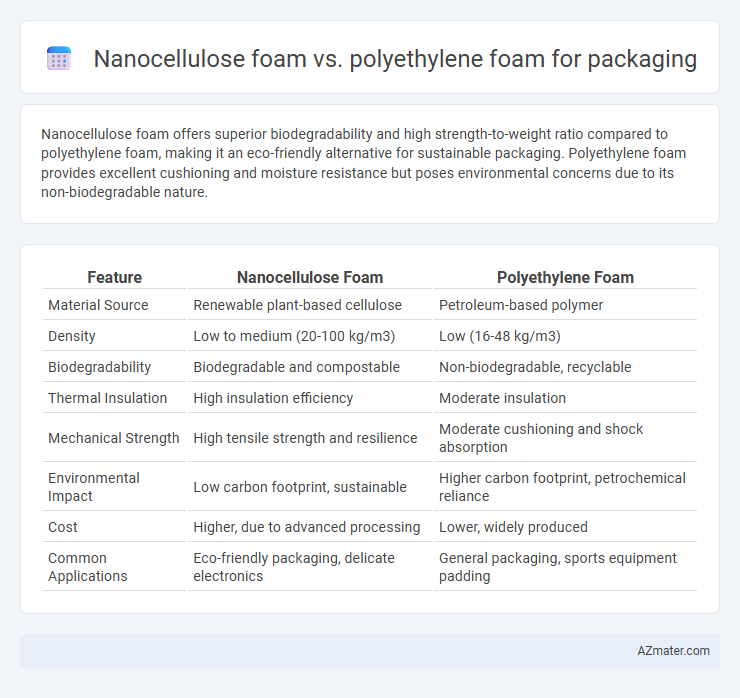Nanocellulose foam offers superior biodegradability and high strength-to-weight ratio compared to polyethylene foam, making it an eco-friendly alternative for sustainable packaging. Polyethylene foam provides excellent cushioning and moisture resistance but poses environmental concerns due to its non-biodegradable nature.
Table of Comparison
| Feature | Nanocellulose Foam | Polyethylene Foam |
|---|---|---|
| Material Source | Renewable plant-based cellulose | Petroleum-based polymer |
| Density | Low to medium (20-100 kg/m3) | Low (16-48 kg/m3) |
| Biodegradability | Biodegradable and compostable | Non-biodegradable, recyclable |
| Thermal Insulation | High insulation efficiency | Moderate insulation |
| Mechanical Strength | High tensile strength and resilience | Moderate cushioning and shock absorption |
| Environmental Impact | Low carbon footprint, sustainable | Higher carbon footprint, petrochemical reliance |
| Cost | Higher, due to advanced processing | Lower, widely produced |
| Common Applications | Eco-friendly packaging, delicate electronics | General packaging, sports equipment padding |
Introduction to Nanocellulose and Polyethylene Foams
Nanocellulose foam, derived from cellulose fibers found in plant material, offers exceptional biodegradability, lightweight strength, and high porosity, making it an eco-friendly alternative in packaging applications. Polyethylene foam, a synthetic polymer material, provides excellent cushioning, moisture resistance, and chemical stability, widely used in protective packaging for fragile goods. Comparing nanocellulose foam and polyethylene foam highlights trade-offs between sustainability, mechanical properties, and environmental impact in modern packaging solutions.
Key Properties of Nanocellulose Foam
Nanocellulose foam exhibits superior biodegradability and renewability compared to polyethylene foam, making it an eco-friendly packaging alternative. Its high porosity and low density provide excellent cushioning and shock absorption while maintaining lightweight characteristics. Nanocellulose foam also offers enhanced mechanical strength and thermal stability, improving protection for delicate products during transportation.
Key Properties of Polyethylene Foam
Polyethylene foam offers excellent impact resistance, high flexibility, and superior moisture resistance, making it ideal for protecting delicate items during shipping and storage. Its closed-cell structure provides exceptional cushioning and insulation properties while maintaining lightweight durability. The foam's chemical inertness and resistance to environmental factors like UV radiation ensure long-lasting performance in diverse packaging applications.
Sustainability and Environmental Impact
Nanocellulose foam offers superior sustainability over polyethylene foam due to its biodegradability, renewable source from plant fibers, and lower carbon footprint during production. Polyethylene foam, derived from non-renewable petroleum, poses significant environmental threats because of its persistence in landfills and contribution to microplastic pollution. The adoption of nanocellulose foam in packaging reduces plastic waste and supports circular economy initiatives by enabling compostable and eco-friendly alternatives.
Performance in Shock Absorption
Nanocellulose foam exhibits superior shock absorption performance compared to polyethylene foam due to its high porosity and exceptional energy dissipation capabilities. The nanofibrillar network structure of nanocellulose allows it to effectively cushion and protect delicate products from impact and vibration. Polyethylene foam, while lightweight and resilient, generally provides lower damping efficiency and recovers slower after compression, making nanocellulose foam an advanced option for sensitive packaging needs.
Moisture Resistance and Barrier Properties
Nanocellulose foam exhibits superior moisture resistance and barrier properties compared to polyethylene foam due to its dense nanofibril network that effectively reduces water vapor transmission. Polyethylene foam, while offering good cushioning, allows higher permeability to moisture and gases, limiting its effectiveness in protecting sensitive products. The bio-based nanocellulose foam also provides enhanced oxygen barrier capabilities, making it ideal for packaging applications requiring extended shelf life and preservation.
Cost Comparison and Industrial Scalability
Nanocellulose foam offers sustainable packaging with a higher initial production cost compared to polyethylene foam, which benefits from established mass manufacturing processes and lower raw material expenses. Industrial scalability of polyethylene foam is well-developed due to decades of optimization, enabling large-volume, cost-efficient output. Nanocellulose foam scalability depends on advancements in cellulose extraction and foam production technologies, which currently limit widespread commercial adoption despite its eco-friendly advantages.
Applications in Packaging Industries
Nanocellulose foam offers superior biodegradability and mechanical strength compared to polyethylene foam, making it ideal for sustainable packaging applications in electronics, food, and fragile goods industries. Its high porosity and lightweight nature provide excellent cushioning and thermal insulation, outperforming conventional polyethylene foam in shock absorption and environmental impact reduction. Packaging industries increasingly adopt nanocellulose foam for eco-friendly solutions that maintain protection standards while minimizing plastic waste.
Biodegradability and End-of-Life Options
Nanocellulose foam, derived from renewable plant fibers, offers superior biodegradability compared to conventional polyethylene foam, which is petroleum-based and persistent in the environment. Nanocellulose foam decomposes naturally within months under composting conditions, making it an environmentally sustainable choice, whereas polyethylene foam often accumulates in landfills and requires energy-intensive recycling processes. End-of-life options for nanocellulose foam include industrial composting and biodegradation, while polyethylene foam primarily relies on mechanical recycling or disposal, presenting challenges in waste management and environmental impact.
Future Trends in Packaging Foams
Nanocellulose foam offers superior biodegradability and sustainability compared to traditional polyethylene foam, aligning with future trends emphasizing eco-friendly packaging solutions. Innovations in nanocellulose processing technology are enhancing its mechanical strength and barrier properties, positioning it as a competitive alternative in protective packaging applications. The growing regulatory pressure on plastic waste and increasing consumer demand for green products drive the accelerated adoption of nanocellulose foam in global packaging markets.

Infographic: Nanocellulose foam vs Polyethylene foam for Packaging
 azmater.com
azmater.com